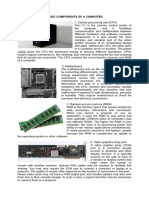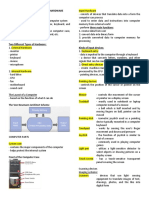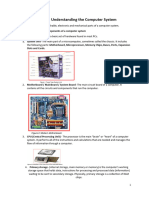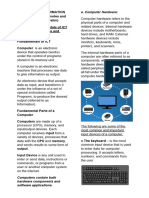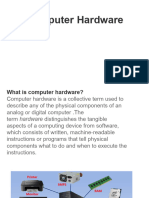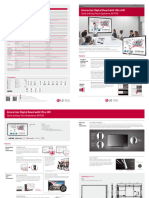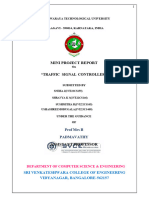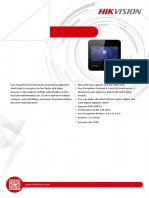Computer Hardware: Definition and Components
Computer hardware is a type of IT asset that refers to the physical and tangible components of
a computer system. It encompasses all the physical devices and equipment that enable a
computer to function and perform various tasks. These components include the central
processing unit (CPU), random access memory (RAM), motherboard, storage devices, input
devices (such as keyboards and mice), output devices (such as monitors and printers), and
other related devices.
Computer hardware is essential for the operation and functionality of a computer system. It
provides the necessary infrastructure for running software and executing instructions. Without
hardware, software alone cannot perform any tasks. Hardware components work together to
process data, store information, display output, and facilitate communication.
The importance of computer hardware lies in its role as the foundation of an organization’s IT
infrastructure. It enables businesses to perform various functions, such as data processing,
storage, networking, and communication. Upgrading or optimizing hardware can lead to
improved performance, increased efficiency, and enhanced capabilities for organizations.
Additionally, advancements in hardware technology have driven innovation and the
development of more powerful and efficient computing systems.
Computer hardware has evolved over time, with advancements in technology leading to
smaller, faster, and more efficient components. Inventors and important figures in the field of
computer hardware include pioneers like Charles Babbage, who conceptualized the idea of a
programmable computer, and Alan Turing, who laid the foundation for modern computing.
Understanding computer hardware and its components is crucial for IT professionals, as it
allows them to diagnose and troubleshoot issues, upgrade systems, and make informed
decisions regarding hardware investments. It is also important for individuals to have a basic
understanding of computer hardware to effectively use and maintain their personal computers.
The components of a computer are listed below:
1. CPU- Central Processing Unit
A CPU is a type of internal computer hardware that serves as the primary component
responsible for executing instructions and performing calculations within a computer system. It
is often referred to as the “brain” of the computer. The CPU, short for Central Processing Unit,
is crucial for the functioning of a computer as it controls the interpretation and execution of
instructions from programs, transforming data input into meaningful information output.
2. Motherboard
A motherboard is a type of internal computer hardware that serves as the main printed circuit
board (PCB) within a computer system. It acts as the central hub that connects and facilitates
communication between various internal components and external peripherals. The
motherboard is crucial for the proper functioning of a computer as it provides the foundation
for all other hardware components to interact effectively.
3. RAM
RAM is a type of internal computer hardware that stands for Random Access Memory. It is a
crucial component of a computer system, serving as the short-term memory where data that
�the processor is currently using is stored. RAM allows the computer to access data much faster
than long-term storage devices like hard disks or SSDs, thereby significantly impacting system
performance.
4. Hard drive
A hard drive is a type of internal computer hardware used for data storage in laptops and
desktop computers. It is a non-volatile storage device, meaning it retains data even when
power is not supplied. The hard drive stores various types of data, including the operating
system, applications, user files, documents, pictures, music, videos, and program preferences.
5. Solid-state drive (SSD)
A Solid-state drive (SSD) is a type of internal computer hardware that serves as a storage device
using flash-based memory technology, typically NAND flash memory. Unlike traditional hard
disk drives (HDDs) that rely on spinning disks, SSDs have no moving parts, which results in
faster data access speeds, improved durability, and reduced power consumption. SSDs provide
persistent data storage by storing information on solid-state flash memory chips.
6. Graphics processing unit (GPU)
A Graphics processing unit (GPU) is a type of internal computer hardware that is specifically
designed to handle and accelerate the rendering of graphics and images on a screen. Originally
developed to enhance computer graphics and image processing, GPUs have evolved to become
essential components in various applications beyond just graphics rendering.
7. Network interface card (NIC)
A Network interface card (NIC) is a type of internal computer hardware that serves as a crucial
component enabling a computer to connect to a network. It is also known as a network
adapter, LAN adapter, or network interface controller. The NIC can be in the form of a circuit
board or chip installed within a computer system, facilitating communication between the
computer and other devices on a network.
8. Optical drive
A Optical Drive is a type of internal computer hardware that allows users to read from and
write data to optical discs such as CDs, DVDs, and Blu-ray discs using laser technology. This
component uses a laser diode to read the data stored on the optical discs by distinguishing
between pits and lands on the disc’s surface based on how the light reflects. Optical drives can
be either internal, installed inside the computer, or external, connected to the computer via
USB or other interfaces.
9. Heat sink
A Heat Sink is a type of internal computer hardware that serves as a passive heat exchanger
designed to dissipate heat generated by electronic or mechanical devices, such as a CPU. It is
typically made of a thermally conductive material, often metal, and is crucial for maintaining
optimal operating temperatures within electronic components.
10. Monitor
�A Monitor is a type of external computer hardware that serves as an output device, displaying
visual information such as images, text, video, and graphics generated by the connected
computer system through the video card. It is an electronic device that falls under the category
of output devices and is also known as a video display terminal (VDT) or a video display unit
(VDU).
11. Keyboard
A Keyboard is a type of external computer hardware that serves as an essential input device
allowing users to input text, characters, numbers, and various commands into a computer or
electronic device. It consists of an arrangement of buttons or keys that act as mechanical
levers, enabling users to interact with the system. The primary function of a keyboard is to
transmit data to the computer system by pressing these keys.
12. Mouse
A Mouse is a type of external computer hardware input device that is used to interact with a
computer system by controlling the movement of the cursor on the screen. It is a hand-held
pointing device that detects two-dimensional motion relative to a surface, typically a desk. The
mouse allows users to navigate graphical user interfaces (GUIs), select items, click on icons,
drag and drop files, and perform various other actions by moving the device across a flat
surface.
13. Speaker
A Speaker is a type of external computer hardware that serves as an electroacoustic
transducer, converting electrical audio signals into corresponding sound waves. It is an
essential output device that allows users to hear audio output from various devices such as
computers, smartphones, and other electronic devices. Speakers work by converting electrical
energy into mechanical energy, causing vibrations or motion in the air that result in sound
waves.
14. Headphones, earphones, earbuds
Headphones, earphones, earbuds are a type of external computer hardware used for audio
output and communication purposes.
15. Microphone
A Microphone is a type of external computer hardware that serves as an input device by
converting sound waves into electrical signals. This transducer device is crucial for capturing
audio and transmitting it to various devices for processing and recording. The microphone acts
as an essential tool for communication, recording, and amplification purposes in various
settings, ranging from live performances to digital recordings.
16. Camera
A Camera is a type of external computer hardware that functions as an optical instrument
designed to capture and store images or videos. It operates by capturing light and processing it
into an image through a lens that focuses the light onto a light-sensitive surface. The camera
essentially consists of a lightproof chamber with an aperture fitted with a lens and a shutter
through which the image of an object is recorded.
17. Touchpad
�A Touchpad is a type of external computer hardware that serves as an input device commonly
found on laptops, netbooks, and other portable devices. It is also known as a trackpad and
provides users with a flat, touch-sensitive surface that allows them to control the cursor and
perform various functions without the need for a traditional mouse. The touchpad typically
replaces the mouse on laptops and netbooks, offering users a convenient way to interact with
their devices.
18. USB flash drive
A USB flash drive is a type of external computer hardware that serves as a portable storage
device utilizing flash memory technology and an integrated USB interface. These devices are
commonly known by various names such as USB stick, USB thumb drive, pen drive, jump drive,
or data stick. They are designed to be plug-and-play, allowing users to easily connect them to a
computer’s USB port for data storage, backup, and file transfer purposes.
19. Memory card
A Memory card is a type of external computer hardware that utilizes flash memory technology
to store digital data. Flash memory is a non-volatile storage medium that retains information
even when power is turned off. These cards are commonly used in various devices such as
digital cameras, smartphones, drones, and other electronic gadgets to provide additional
storage capacity for storing photos, videos, documents, and other digital content.
20. Joystick
A Joystick is a type of external computer hardware input device used to control the movement
or actions of a digital object on a computer screen. It typically consists of a handle or stick that
pivots on a base and reports its angle or direction to the device it is controlling. Joysticks are
commonly used in various applications, including video games, medical devices, industrial
equipment, and flight simulators.
21. Stylus
A Stylus is a type of external computer hardware that serves as a pen-like instrument used for
interacting with touchscreens, such as those found on smartphones and tablets. It is designed
to provide users with a more precise and comfortable way to write, draw, navigate, and input
commands on touch-sensitive devices. The stylus typically features a fine tip that allows for
accurate input and mimics the functions of a pen or pencil on a screen.
22. Scanner
A Scanner is a type of external computer hardware input device that optically scans images,
printed text, handwriting, or objects and converts them into a digital format that can be
viewed, edited, or stored on a computer. Scanners use light-sensitive components and lenses to
capture images and then convert them into digital signals. This process allows physical
documents or objects to be digitized and stored electronically.
23. Printer
A Printer is a type of external computer hardware output device that accepts text and graphic
output from a computer and transfers the information to paper or other materials. Printers
play a crucial role in generating hard copies of digital documents, images, or text files. They are
�essential components in various settings, including homes, offices, educational institutions, and
businesses.
Hardware externo
Hardwares externos são peças ligadas a uma das inúmeras entradas que um computador pode
ter. Normalmente, eles são baseados no recurso Plug & Play, permitindo seu uso básico sem
instalações de softwares ou atualizações.
Impressora
Impressoras são os hardwares externos usados quando é necessário transformar documentos
digitais em papéis físicos. Para isso, esses dispositivos precisam estar conectados a um
computador por meio de uma rede ou de um cabo USB. Elas têm recursos diferentes conforme
a marca e a tecnologia.
Monitor
Monitores são componentes que exibem imagens e textos na forma de vídeo em uma tela.
Esse dispositivo é essencial para gerenciar ou utilizar qualquer sistema informatizado moderno
que dependa da inserção de comandos, pois é por meio dele que os usuários conseguem
operar de maneira simplificada um computador.
Eles podem ser conectados ao equipamento por meio de uma conexão digital, portas HDMI,
DVI ou cabo analógico.
Mouse
É um pequeno dispositivo de entrada capaz de apontar, selecionar e clicar em objetos,
aplicativos, navegadores e demais elementos dispostos na tela. Um mouse também conta
com uma roda de rolagem que permite mover o cursor para baixo e para cima enquanto o
usuário faz a leitura do que está sendo exibido.
Normalmente, eles são divididos em dois botões com funções específicas. O primeiro, do lado
esquerdo, é responsável pela seleção e abertura dos ícones do computador. O segundo, por
sua vez, abre opções referentes a aquele elemento, como copiar, colar, cortar e as
propriedades de um arquivo.
Teclado
Teclados são dispositivos compostos por interruptores, botões ou teclas usadas para digitar
palavras e dar comandos a um computador. Esse é o principal dispositivo de entrada desde o
início da computação moderna.
Leitores de discos
São componentes que leem dados de um DVD, CD, disco Blu-ray ou demais formatos.
Geralmente são fabricados com material magnético e revestidos com óxido de ferro.
�Inicialmente, as unidades de disquete eram muito populares entre os usuários de
computadores.
External hardware is a component that connects to one of the many inputs a computer may
have. Typically, it's Plug & Play, allowing basic use without software installation or updates.
Printer
Printers are external hardware used to convert digital documents into physical paper. To do
this, these devices must be connected to a computer via a network or USB cable . They have
different features depending on the brand and model.technology.
Monitor
Monitors are components that display images and text in video format on a screen. This device
is essential for managing or using any modern computer system that relies on inputting
commands, as it allows users to operate a computer in a simplified manner.
They can be connected to the equipment via a digital connection, HDMI, DVI ports or analog
cable.
Mouse
It's a small input device capable of pointing, selecting, and clicking on objects, applications,
browsers, and other elements displayed on the screen . A mouse also has a scroll wheel that
allows the user to move the cursor up and down while reading what's being displayed.
Typically, they're divided into two buttons with specific functions. The first, on the left, is
responsible for selecting and opening computer icons. The second, in turn, opens options
related to that element, such as copy, paste, cut, and file properties.
Keyboard
Keyboards are devices composed of switches, buttons, or keys used to type words and give
commands to a computer. They have been the primary input device since the beginning of
modern computing.
Disc players
These are components that read data from DVDs, CDs, Blu-ray discs, or other formats. They are
typically made of magnetic material and coated with iron oxide. Initially, floppy disk drives
were very popular among computer users.






















